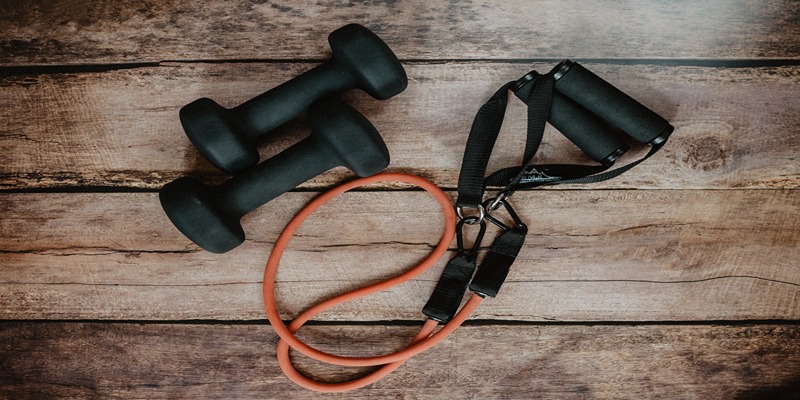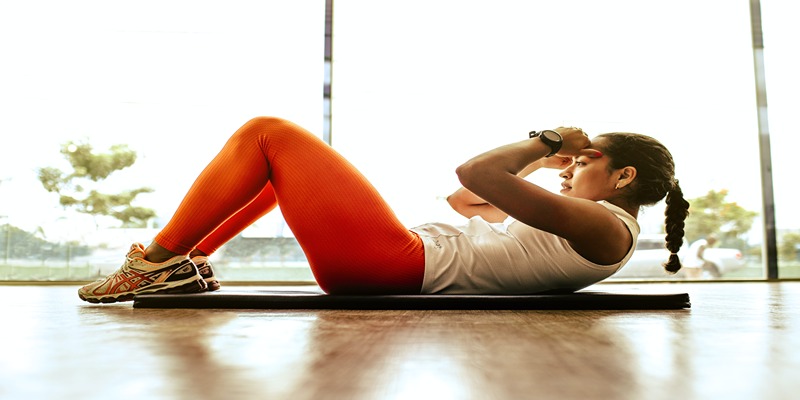Mastering the Art of Home Workouts for Peak Physical Fitness
Dec 02, 2023 By Madison Evans
The convenience and efficacy of exercising at home have contributed to their meteoric rise in popularity. This article explores the realm of at-home workout methods, shedding light on the rising popularity of exercising without leaving the house. For those with busy schedules or specific fitness objectives, working out from home has become a viable alternative to going to the gym. Because of their adaptability, people may tailor their habits to fit their own needs and busy schedules. The advantages of working out at home go beyond just being more convenient; they also include conserving money, exercising in private, and setting one's own pace. No matter your fitness level or experience level, working out at home is a great way to get in shape and get health benefits.

Effective Home Workouts: Core Principles
Key Components of Successful Home Exercise Routines
There are a number of important factors that, when combined, increase the effectiveness of a home fitness program. Achievable and specific fitness objectives should be the starting point. Outlining your goals before you begin your exercises can help you stay on track, whether that's to lose weight, grow muscle, increase flexibility, or improve your general fitness. The same holds true for variety; to keep your body challenged and avoid boredom, include a wide range of workouts within your program. Sticking to a consistent exercise routine helps develop momentum and enables long-term progress—consistency is the foundation of success. Learning how to exercise correctly is also critical for getting the most out of your workouts with the least amount of danger of damage. You may hone your technique with the help of online lessons or virtual exercise sessions. Dumbbells, resistance bands, and yoga mats are some of the fundamental pieces of exercise equipment that you may want to purchase. Lastly, a vital idea for sustainable growth is to embrace progression, which means to progressively increase and vary your exercises as your fitness level develops.
Balancing Cardio, Strength, and Flexibility Training
Integrating aerobic, strength, and flexibility training in a balanced manner is essential for achieving a comprehensive home exercise program. Activities that increase heart rate and endurance are known as cardiovascular exercises. These include running in place, vigorous walking, and jumping jacks. The best way to keep your heart healthy is to do moderate-intensity exercise for at least 150 minutes per week. Supplementing this with strength training—whether that's using resistance bands, conventional weightlifting, or activities that rely on your own body weight (such as squats and push-ups)—allows you to gain muscle and speed up your metabolism. To keep things in check, try to fit in strength training sessions twice or thrice weekly. Last but not least, workouts that focus on flexibility and mobility, such as yoga, Pilates, or stretches, are essential for boosting balance, improving posture, and increasing joint mobility. If you want to build a comprehensive fitness program that meets your individual needs and encourages you to lead a better, more active lifestyle without leaving your house, try mixing cardio, weight training, and flexibility exercises into your home workouts.
Optimal Home Fitness: Bodyweight Exercises
Focus on Bodyweight Exercises for Overall Fitness
When you want to get in shape without leaving your house, bodyweight workouts are a great place to start. Because you can use your own body weight as resistance, these workouts are great for people of all fitness levels and budgets because they don't need expensive gym equipment. One major benefit of bodyweight workouts is the variety of motions that may be performed to work different muscle groups. Bodyweight exercises give you the freedom to design a full-body routine that fits your unique fitness goals, whether that's strengthening your lower body with squats and lunges or strengthening your upper body and core with push-ups and planks. It is also impossible to exaggerate the practicality of bodyweight workouts. They are perfect for home exercises since you can do them in any little area, and you don't need any extra equipment. Bodyweight workouts are a great way to get in shape without spending a fortune on expensive or specialized equipment.
Examples and How-To Guides
Here are some important examples and detailed instructions to help you get started with bodyweight exercises for home fitness:
The triceps, shoulders, and chest are worked out in this traditional upper-body move. Put your hands shoulder-width apart to form a plank. Pull yourself down until your chest is almost touching the floor, then lift yourself back up. If you are just starting out or need a less strenuous version of this workout, try knee push-ups instead.
To build stronger quadriceps, hamstrings, and glutes, squats are an excellent exercise to do. Step down by bending at the knees and pushing back at the hips after standing with your feet wide apart. If you stand up straight, you're back in the standing position.
While planks are most known for strengthening the abdominal muscles, they also work the upper body, lower back, and shoulders. Start by doing push-ups while supporting your body weight with your forearms. Engage your core muscles and keep your body in a straight line from your head to your heels. For maximum core endurance training, stay in this posture for the whole allotted time.
The glutes, hamstrings, and quadriceps receive a good workout with a lunge. To do a lunge, move forward on one foot, bend both knees to bring your body to a 90-degree angle, and then push off the front foot to get back to where you started.
Bodyweight exercises may be done in a variety of ways; nevertheless, these examples show the basics. There are a plethora of instructional materials and workout apps available online that provide detailed instructions with pictures for every move. Bodyweight exercises are a great way to get in shape at home since you can work on your strength, flexibility, and general fitness without investing in expensive or specialized equipment.

Incorporating Equipment in Home Workouts
Incorporating equipment into your home exercises may greatly enhance them by adding variety and intensity. There are practical methods to make the most of your home exercises, whether you're thinking of using ordinary household objects or investing in budget fitness equipment.
Utilizing Common Household Items for Exercise
If you're looking for an inexpensive and accessible way to get in shape, you may be surprised to know that you can utilize several common household products in a new way. To improve your bodyweight workouts, you may use sturdy chairs as secure platforms for sitting leg lifts, tricep dips, and step-ups. When you fill water bottles to different levels, you may use them as substitute dumbbells to do resistance workouts like lateral raises and bicep curls. To make your exercises more interesting, try using a towel on a smooth surface to do hamstring curls or sliding mountain climbers. You can use anything heavy, like a rucksack full of books, to create a weight vest for activities like push-ups, squats, and lunges. Stair climbing and step-ups are great cardiovascular exercises that you can do on your own home steps, which engage your lower body and heart.
Recommendations for Affordable Fitness Equipment
Strength training activities are made easier using resistance bands, which come in a variety of levels and are easy to transport and store. When practicing yoga on the floor, a yoga mat may be a lifesaver due to its non-slip surface, padding for joints, and increased stability. Cardiovascular exercises, better coordination, and calorie burning are all greatly enhanced by jump ropes. By letting you swap out the weight plates, adjustable dumbbells make strength training more versatile. You may use an exercise ball for stability drills, core workouts, and even to sit up straight at your workplace without straining your back. There is a kettlebell for every strength and conditioning activity imaginable, from squats to swings, and they come in a variety of sizes.
Conclusion
Household objects or inexpensive exercise gear may be used to boost the efficiency of home workouts, which are already a simple and efficient method to remain healthy. Versatility and originality in your routines may be enhanced using common home objects, and training possibilities can be expanded with budget-friendly fitness equipment. Consistency and commitment are the two most important factors in getting the most out of your home exercises. Maintaining an active and healthy lifestyle doesn't have to include spending a fortune on a gym membership. All you need is a personalized routine and the right equipment to meet your objectives.







